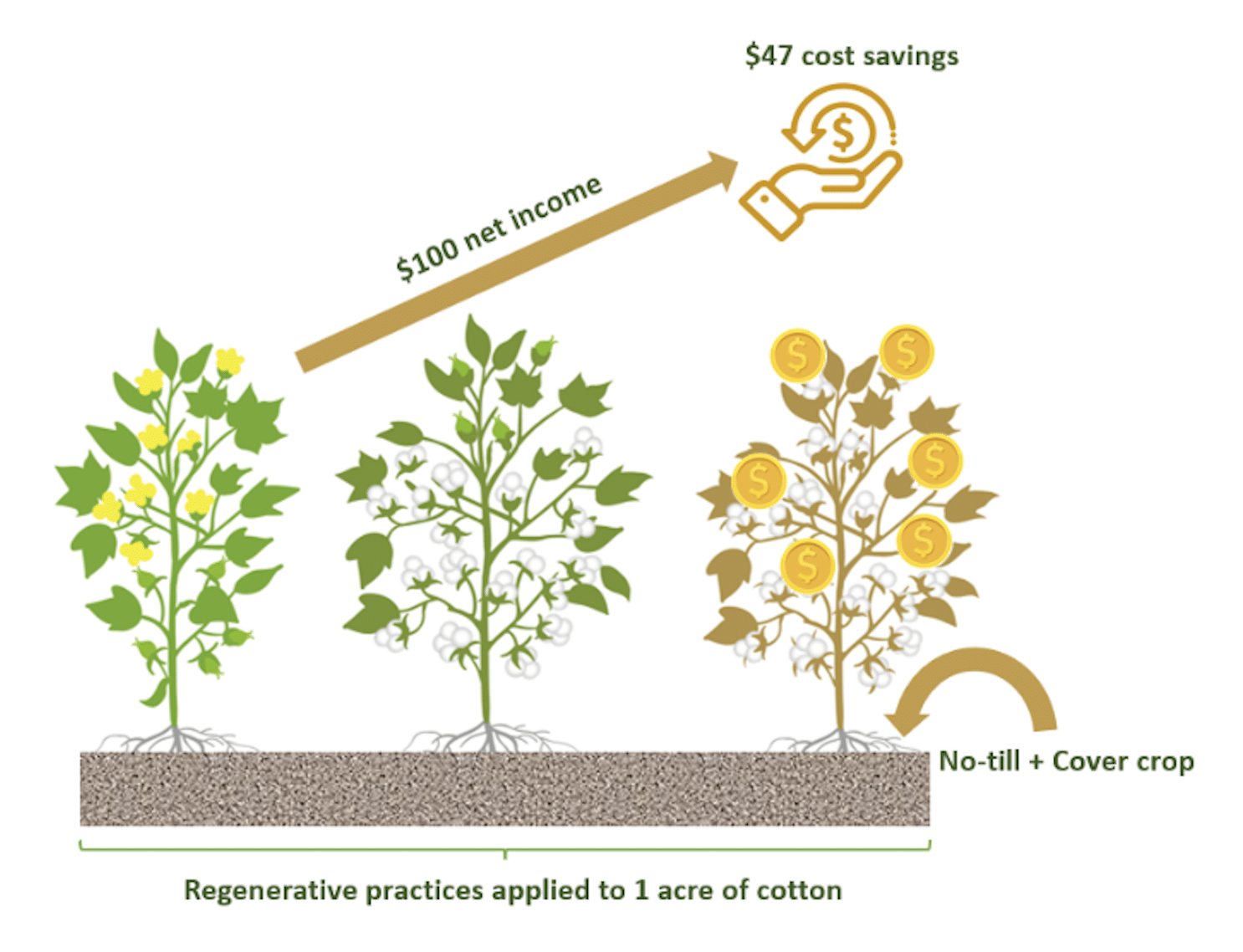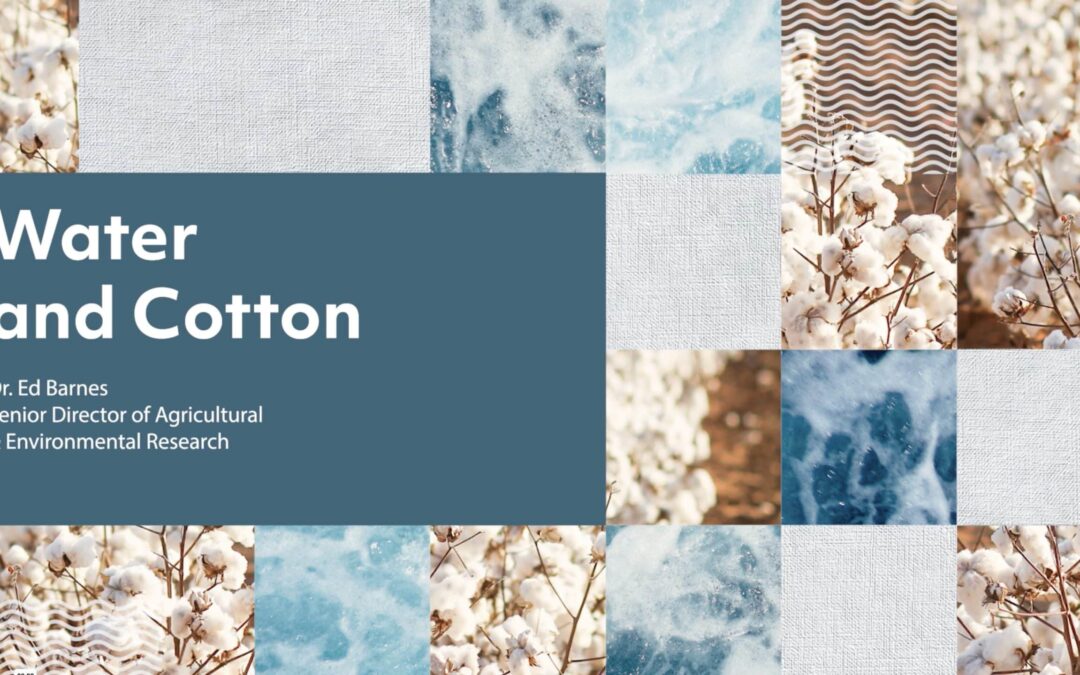REGENERATIVE BENEFITS
The Benefits of Regenerative Agriculture in Cotton Farming
Cotton Incorporated believes in the power of regenerative agriculture practices to promote sustainability. By adopting regenerative techniques, cotton growers can enhance their environmental stewardship, improve soil health, mitigate climate change and foster a more resilient agricultural system.
Whether a cotton grower, consumer or brand, understanding these benefits can inspire positive change and contribute to a more sustainable future.

Sustainability for Brands and Consumers
With growing consumer awareness and demand for sustainable products, incorporating regenerative cotton into brands’ products can attract environmentally conscious shoppers. According to research from Cotton Council International (CCI) and Cotton Incorporated’s 2021 Global Sustainability Survey, a remarkable 71% of consumers are willing to pay a premium for clothing made with sustainable materials[1]. By using cotton grown with regenerative practices, they can align themselves with consumer values and make a positive impact on the environment.
Regenerative practices also foster closer relationships between growers and supply chain partners. By supporting regenerative agriculture, brands can actively contribute to the promotion of sustainable farming practices.
Social and Economic Benefits for Cotton Growers
Regenerative agriculture practices can have a positive impact on the social and economic well-being of cotton growers. By adopting these practices, growers can increase their profitability and build resilience against climate shocks. This, in turn, can lead to better working conditions, higher wages, and improved livelihoods for workers in the cotton industry.
Recent studies by the Soil Health Institute have shown that cotton growers who implemented no-till and cover crop practices reported an average cost savings of $47 per acre and an increase in net income of $100 per acre for cotton [2] [Fig.1]. These financial benefits demonstrate that regenerative practices not only contribute to environmental sustainability but also have a positive impact on growers’ economic viability.

Figure 1: Economic benefits of regenerative agriculture for cotton growers, based on SHI data [2]
Preserving Land for Future Generations
For multi-generational cotton farms in the United States, preserving the long-term health and productivity of the land is of utmost importance. By adopting regenerative agriculture practices, such as enhancing soil health, increasing organic matter content, and promoting biodiversity, farmers ensure that the soil remains fertile and productive for future generations. This commitment to sustainable stewardship aligns with the core values of family-owned farms, which make up a vast majority of the operations in the U.S.
Regenerative practices offer various benefits to farmers, including improved crop yields and reduced input costs. Additionally, these practices contribute to broader benefits, such as less dusty air and improved runoff water quality. By considering the broader impact of regenerative agriculture on the environment and surrounding communities, farmers play a crucial role in creating a more sustainable and resilient agricultural system.
Mitigating Climate Change
Regenerative agriculture practices have significant potential to mitigate climate change and reduce greenhouse gas emissions. Healthy soil acts as a powerful carbon sink, sequestering carbon from the atmosphere and improving water and air quality. In the U.S., cotton has seen a 25% reduction in greenhouse gas emissions since 1980 [3] .
Through practices like cover cropping and no-till farming, regenerative agriculture aids in capturing carbon and storing it in the soil. By improving soil health on agricultural lands in the U.S., up to 250 million metric tons of carbon could be stored annually [3] . Moreover, increasing the efficiency of synthetic fertilizers used in cotton production helps combat climate change, as fertilizer production and field emissions account for nearly 60% of cotton’s climate change impacts [5] .
The proactive measures taken by U.S. farmers in adopting regenerative practices have resulted in an annual rise of over 8.8 million tons of carbon being stored in cultivated cropland soils, including cotton yields [6]. The U.S. Climate Smart Cotton Program, designed to assist U.S. cotton growers in adopting sustainable practices that address climate change, plays a significant role in equipping farmers with knowledge and tools to meet the fashion industry’s demand for cotton with a significantly lower carbon footprint. This program also enhances the competitiveness and revenue potential of U.S. cotton farms [7][8] .
Driving Change in Cotton Production
Although conventional agricultural practices are still prevalent in the U.S. [9], there has been a positive shift toward the adoption of regenerative practices.
- Between 2012 and 2017, the number of planted cover crop acres increased by nearly 50% [10].
- Furthermore, around 45% of U.S. cotton farmers use reduced or no-till practices, with the percentage being even higher in Australia, at approximately 70% [11].
- Over the past 40 years, American cotton farmers have managed to reduce soil loss by 45%, decrease water usage by 58%, and cut greenhouse gas emissions by 25%, all while increasing land use efficiency by 30% [4].
- The cotton industry aims to further enhance soil health by increasing soil carbon by 30% and reducing soil loss per acre by 50% between 2015 and 2025, as pledged by U.S. cotton growers [12].

Figure 1: Trends and progress in the adoption of regenerative agricultural practices in the U.S. [13].
By embracing regenerative farming, the cotton industry continues to move towards a more sustainable future. As farmers, brands and consumers unite in support of regenerative practices, these individuals forge a path toward lasting, positive change for both the cotton industry and the environment.
THE LATEST

Water & Cotton
Discover the truth about cotton’s water usage. Is it really a water-thirsty crop? Learn about drought tolerance, water-saving practices, and how much water is needed to make a cotton t-shirt.
Cotton’s Natural Biodegradability: Water
Discover why cotton is a sustainable choice. Cotton is a biodegradable, drought-tolerant crop and helps reduce plastic waste in our oceans. Check the label for cotton and help save our water.
Amid Increasing Climate Change Challenges, Cotton Continues to Make Water...
Water remains one of the most important resources due it its impact on our everyday lives, especially as we work with our changing environment. The impact of climate change, however, has made it challenging for growers to manage this resource. Currently, nearly half...